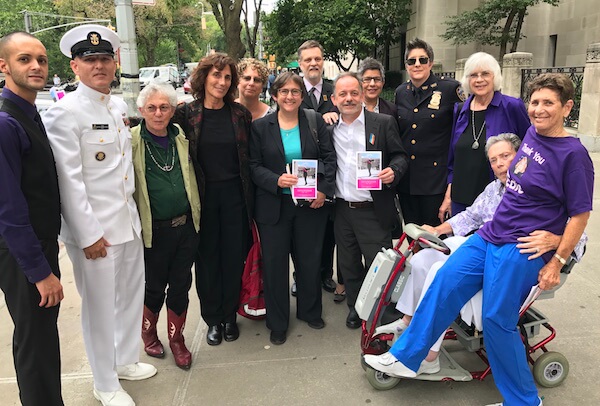Among the successful plaintiffs in the New Mexico marriage equality case are Kim Kiel and Rose Griego, and Miriam Rand and Ona Porter. | ACLU OF NEW MEXICO
The New Mexico Supreme Court has ruled unanimously that denying same-sex couples the right to marry violates the State Constitution’s Equal Protection Clause.
In a December 19 opinion for the court, Justice Edward L. Chavez wrote, “We hold that the State of New Mexico is constitutionally required to allow same-gender couples to marry and must extend to them the rights, protections, and responsibilities that derive from civil marriage.”
The court’s ruling was widely anticipated in light of the tone of the oral arguments before the court.
State's high court rules several months after trial judges ordered some counties to issue licenses
This past summer –– in the wake of the US Supreme Court’s decision striking down the Defense of Marriage Act’s ban on federal recognition of legal same-sex marriages –– several New Mexico trial courts directed county clerks to issue marriage licenses to gay and lesbian couples. The New Mexico Constitution gives the State Supreme Court authority to take appeals directly from the trial courts, bypassing the intermediate court of appeals, “where it is deemed to be in the public interest to settle the question involved at the earliest moment.” So when the New Mexico Association of Counties asked the high court to definitively resolve the question of same-sex marriage without waiting for it to percolate up through the appellate process, the court agreed. With some counties issuing licenses to gay and lesbian couples and others not, the court viewed the situation as “chaos statewide.”
Given the gender-neutral language of many of New Mexico’s marriage-related statutes, the court first had to determine whether same-sex marriage was already allowed. Looking to the intent of the Legislature at the time those laws were enacted, the court concluded it was not –– a viewed bolstered by the use of “husband” and “wife” in some of them.
The plaintiffs had argued alternatively that denying marriage to same-sex couples violated equal protection and deprived them of a fundamental right. Since the court decided the case on equal protection grounds, it never turned to the fundamental right issue.
On the equal protection question, opponents of marriage equality argue that same-sex couples are not similarly situated to different-sex couples because they cannot procreate with each other on their own. Rejecting this position, Justice Chavez wrote, “Fertility has never been a condition of marriage, nor has infertility ever been a specific ground for divorce.” It is also not true, the court found, they are not similarly situated, given that same-sex couples can adopt or employ reproductive technology to have children, just as some different-sex couples do.
In any event, procreation is a bit beside the point, in the court’s view, since the purpose of the state’s marriage laws “is to bring stability and order to the legal relationships of committed couples by defining their rights and responsibilities as to one another, their property, and their children, if they choose to have children.” The highest courts in California, Connecticut, and Iowa reached the same conclusion, Chavez’s opinion noted.
One of the plaintiffs’ arguments was that the case was about sex discrimination, which, because of the State Constitution’s Equal Rights Amendment, would have subjected the law to a “strict scrutiny” standard of judicial review, making it very difficult to defend. The high court found that there was no sex discrimination, since both men and women are equally barred from marrying same-sex partners.
Instead, the court analyzed the case as a question of sexual orientation discrimination, and had to determine whether strict scrutiny also applied here or if the more customary “rational basis” review, under which courts give significant deference to legislative enactments, was called for. In the end, the court found that an intermediate level of review was appropriate.
Strict scrutiny is applied when examining discrimination claims regarding classes of people who have historically faced pervasive discrimination. In response to the argument that gays have now become a politically powerful group, the court concluded “that effective advocacy for the LGBT community is seriously hindered by their continuing need to overcome the already deep-rooted prejudice against their integration into society, which warrants our application of intermediate scrutiny in this case.”
The persistence of the closet, the court found, is significant in this regard. “It is reasonable to expect that the need of LGBTs to keep their sexual orientation private also hinders or suppresses their political activity,” Chavez wrote.
Despite the steady advances in the marriage equality fight, the court noted that most states still ban it and, like the federal government, also fail to provide basic nondiscrimination protections.
As the result, the court embraced intermediate scrutiny of the marriage laws, under which they were presumed unconstitutional and the burden was on those defending them to show they advance an important state interest.
The court then rejected all the arguments put forward by the State of New Mexico and a variety of groups that filed briefs in favor of its position –– namely, the need to promote responsible procreation, to support responsible child-rearing, and to prevent the “deinstitutionalization of marriage.”
“We fail to see how forbidding same-gender marriages will result in the marriages of more opposite-gender couples for the purpose of procreating, or how authorizing same-gender marriages will result in the marriages of fewer opposite-gender couples for the purpose of procreating,” Chavez wrote. In fact, given the burdens of “either lengthy and intrusive adoption procedures or assistive reproduction” that same-sex parents face, the court found, they are virtually models of responsible procreation.
On the question of raising children, Chavez’s opinion pointed to voluminous evidence supporting the abilities of same-sex couples to raise children well and also noted that New Mexico law already supports same-sex couples as parents. “We fail to see how depriving committed same-gender couples, who want to marry and raise families, of federal and state marital benefits and protections will result in responsible child-rearing by heterosexual married couples,” he wrote. “In the final analysis, child-rearing for same-gender couples is made more difficult by denying them the status of being married and depriving them of the rights, protections, and responsibilities that come with civil marriage.” He added, “There is nothing rational about” that.
On claims regarding the “deinstitutionalization of marriage,” the court found no evidence that fewer different-sex couples have married in jurisdictions where same-sex couples have been allowed to.
New Mexico is now the 17th state –– plus the District of Columbia –– to embrace marriage equality, a group that makes up nearly 38 percent of the nation’s population. That figure is building toward a critical mass that would be very useful for the Supreme Court to see when one or more of the 40-plus pending marriage equality lawsuits raising federal constitutional questions finally makes it to the nation’s highest tribunal.
Several cases were folded into the appeal that went to the New Mexico Supreme Court. The plaintiffs were represented by the National Center for Lesbian Rights and the LGBT Rights Project of the American Civil Liberties Union, as well as the ACLU of New Mexico and several local cooperating attorneys.



































